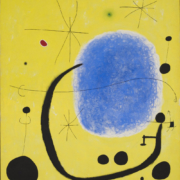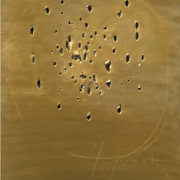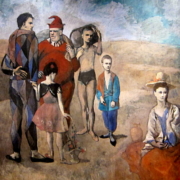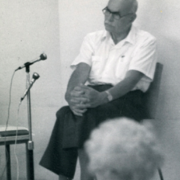The place of the Unconscious is not only the individual mind: comparison beetween models
The relation between the configuration of the internal world and the individual’s interpersonal relations has been widely debated in the psychoanalytical world. This debate made it possible to open clinical work to new areas of intervention, where the object is no longer only the single individual, but his relations with a parent – in child psychoanalysis – a partner, the family – in couple or family psychoanalysis – with the members of a group. This implied not only a revision of the models and the theory of technique, but led to the identification of new types of patients and a new view of psychopathology.
In the current psychoanalytical models there is a more widespread view of a tighter relation between the outline of the internal world (internal objects, self, intersubjectivity) and the enactment of actual relations, so that interpersonal relations have become the scenario where the internal world resides (Person, Cooper, Gabbard, 2005). This aspect is evident in the relation between a parent’s internal organization and his relations with his children, a partner’s internal organization and his couple relation and it appears very clearly in the phenomena taking place in groups (Lieberman, Van Horne, 2005; Neri, 2005, 2007; Eiguer, Granjon, Loncan, 2006; Kaës, 2006; Fonagy, Target, 2007; Santona, Zavattini, 2007; Zavattini, 2006).
Already in 1935 Balint (Balint, 1935) suggested to pay more attention to the development of object relations, in the sense that all the terms and concepts of psychoanalysis, except for “object” and “object relations” were referred to a single individual, thus signalling the limits of the traditional view of personality centred on the so called one body psychology, i.e. the exclusive focus on the features of the individual mind seen as self-standing and the only real place of the unconscious.
In current psychoanalysis, on the contrary, the function of the relation with the other, seen as one of humankind’s motivational systems, contributed to the definition of a new theoretical view: from an infant defending itself from the world to an infant relating to the world and affected by it, to an infant that is affected by and affects the environment around it.
The changes undergone by this issue in the psychoanalytical movement are well known: from the theories of object relations that deeply reviewed the Freudian paradigm to the more recent intersubjectivistic stances (Mitchell, 2000) that recovered the issue of the relation between the configuration of the internal world and the nature and development of interpersonal relations (Beebe, Lachmann, 2002; Mayes, Fonagy, Target, 2007).
This research lines determined relevant reflections in the international psychoanalytical movement with a special focus on the psychoanalytical couple as matrix from which meanings processually emerge and where the vicissitudes of the analyst-parent encounter are defined (Gallese, Fadiga, Fogassi, Gill, 1993; Ferro, 1996; Bezoari, Ferro, 1997; Bromberg, 1998/2001; Gabbard, Westen, 2003).
Bion’s work (Bion, 1961, 1962) and the concept of basic assumptions have been very important because they gave rise to the question of how psychoanalytical ideas could be adjusted to a group setting or how psychoanalytical concepts do not fit in group settings. In other words, paraphrasing Balint’s observation, we could ask if the individual is a different entity from the group, that is made up by a group of individuals and if these two entities, the individual and the collective entity, are totally different. The question was posed by Corrao (1998): <<Do we need different theories for each of these two levels?>>.
The reflections derived from Bion’s work on groups and on serious patients (Bion, 1961, 1967) facilitated the ability to get free from the dissymmetry of roles between analyst and patient and to enter the game of variable and circular dissymetries, not so much because of affects related to one’s being a child or a member of a family, as Freud thought, but of affect for the context – or field – where the therapeutic relation takes place.
In this sense, today the idea of a thinning of the distinction between subject and object seems less dramatic if we consider the contribution of neurosciences. The discovery of mirror neurons – active when actions aimed to a certain goal are performed and also when the same actions performed by others are observed – illustrates in fact << […] innate and pre-programmed ability to internalize, incorporate, assimilate, imitate etc. the state of another and the mirror neurons represent the basis for this ability. But for reaching its full expression this predisposition requires as complement an adequate behaviour in the caregiver mirroring it, interacting with it in a consistent and foreseeable way. All these conceptualizations, quite different from one another and coming from different theoretical backgrounds, stress the importance of the (external o internally represented) object in mirroring the self as a basic mode for restructuring the internal world>> (Gallese, Migone & Eagle, 2006).
The question of the relations between individual organization and relational aspects in the psychoanalytical debate is a basic issue that no longer concerns the anticipating reflection deriving from the study of groups but went beyond the vertical model of repression and the horizontal model of splitting.
Where is now the place of the unconscious? This question pervades psychoanalysis, notwithstanding the differences in models, in explored areas and theoretical traditions of the various countries, such as those between the French and British traditions, as will be clearly seen in the papers published in this issue.
We invited a few Italian and non-Italian psychoanalysts to participate in this debate, which does not aim at being systematic, but should rather be considered as an invitation to a forum where different positions can confront each other and provide new insights. We express our warmest thanks to all those who contributed to this issue of Funzione Gamma and to those who could not but we hope will be able to do it in the future.
Readers will then find different and not always comparable views on which to reflect: the issue of original fantasies as link between individual mind and family, in Anne Loncan’s essay Fantasies, myths and dreams as witnesses of family psychic groupality. The return to Bionian issues but at the level of group psychic apparatus in René Kaës essay, Pour une troisième topique de l’intersubjectivité et du sujet dan l’espace psychique commun et partagé. The question of object relations and the regulation of emotions as in David and Jill Scharff’s essay, The interpersonal Unconscious, which contains references to the neurosciences and to intergenerational transmission in terms near to infant research. The essay by Patrizia Velotti and Zavattini, The encounter with the other in couple relations: the place of mutuality, where couple relations as seen as one of the places where the negotiation of intersubjectivity takes place. The question of myths in Ravit Raufman’s essay, Folkloristic Methods in Dream Interpretation.
References
Balint, M. (1935). Critical Notes on the Theory of Pregenital Organisations of the Libido. In M. Balint, Primary Love and Psychoanalytic Technique in Psychoanalysis. London: Hogarth Press.
Beebe, B., Lachmann, F. (2002). Infant Research and Adult Treatment: Co-constructing Interactions. New York: The Analytic Press.
Bezoari, M., Ferro, A. (1991). Percorsi nel campo bi-personale dell’analisi. Rivista di Psicoanalisi, 35, 5-47.
Bromberg, P. M. (1998/2001). Standing in the Spaces, Essays on Clinical Process, Trauma and Dissociation. New York: The Analytic Press,.
Bion, W. R. (1961). Experiences in Groups and other Papers. London: Tavistock Publications.
Bion, W. R. (1962). Learning from Experience. London: Medical Books–Ltd
Bion, W. R. (1967). Second Thoughts. London: Heinemann.
Corrao, F. (1998). Orme.Milano: Raffaello Cortina Editore.
Eiguer A., Granjon, E., Loncan, A. (2006). La part des ancêtres. Paris: Dunod.
Ferro, A. (1996). Nella stanza d’analisi. Emozioni, racconti, trasformazioni. Milano: Raffaello Cortina Editore.
Fonagy, P. e Target, M. (2007). Playing with Reality: IV. A theory of external reality rooted in intersubjectivity. International Journal of Psychoanalysis, 88, 917-937.
Gabbard, G. O., Westen, D. (2003). Rethinking Therapeutic Action. International Journal of Psycho-Analysis, 84, 823-841.
Gallese, V., Fadiga, L., Fogassi, Gill, M. M. (1993). One-Person and Two-person Perspectives: Freud’s “Observation on transference-Love”. In E. Spector Person, A. Hagelin, P. Fonagy, On Freud’s Observations on Transference-Love. New Haven and London: Yale University Press.
Gallese, V., Eagle, M. N., Migone, P. (2007). Intentional attunement mirror neurons and the neural underpinnings of interpersonal relation. Journal of the American Psychoanalytic Association, 55, 132-176.
Kaës, R. (2006). La matrice groupale de la subjectivation. Les alliances inconscientes. In F. Richard, S. Wainrib et al., La subjectivation (pp. 139-162).Paris: Dunod.
Lieberman, A., Van Horn, P. (2005). Don’t Hit my Mommy! A Manual for Children-Parent Psychotherapy with Young Witness of family Violence. Washington: Zero to Three Press.
Mitchell, S. (2000). Relationality: From attachment to intersubjectivity. New York: Analytic Press, Hillsdale.
Mayes, L., Fonagy, P., Target, M. (2007). Developmental Science and Psychoanalysis. Integration and Innovation. London: Karnac.
Neri, C. (2005). Gruppo. Roma: Borla.
Neri, C. (2007). La nozione di campo allargata in psicoanalisi. Rivista di psicoanalisi, 1, 103-134.
Person, E. S., Cooper, A. M., Gabbard, G. O. (2005). The American Psychiatric Publishing Textbook of Psychoanalysis. Washington Dc and London: Psychiatric Publishing, Inc.
Santona, A., Zavattini, G.C. (2007). La relazione di coppia. Strumenti di valutazione. Roma: Borla.
Scharff, J., Scharff, D. (1998). Object Relations Individual Therapy. Northvale NJ: Jason Aronson.
Zavattini, G. C. (2006). El “espacio triangular” y el setting en la psicoterapia psicoanalítica de pareja. Psicoanalisis & Intersubjetividad. Familia, pareja, grupos e instituciones, 1. www.intersubjetividad.com.ar/






